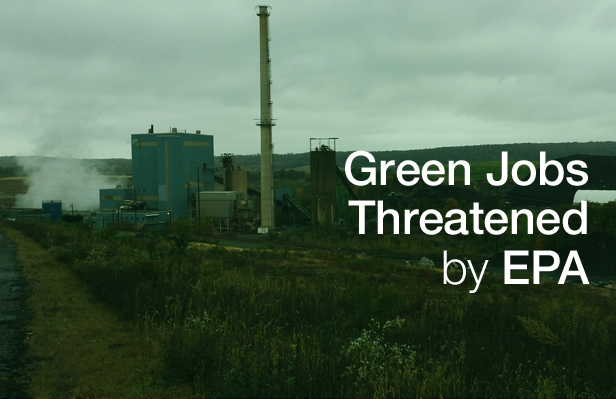Commentary

Green Jobs Threatened by EPA Regs
John Oelbracht has managed the Westwood Generation power plant in Schuylkill County for 10 years. It’s more than a job to him—it’s an undertaking to clean up the environment while producing power for Pennsylvania homes.
“We’re on something of a mission here,” Oelbracht says. But if the EPA has its way, he could soon be out of a job.
Oelbracht and 35 workers at the plant are threatened by extreme carbon-emission regulations proposed by the U.S. Environmental Protection Agency (EPA). The new regulations could force the closure of Westwood and 13 other plants like it in Pennsylvania, as well as five more in other states.
All told, the regulations put in jeopardy hundreds of thousands of jobs in the coal and power industries, including nearly 1,000 at the nation’s 19 coal-waste plants.
Standing atop the Westwood plant, Oelbracht explains how burning 1,200 tons of coal waste—called “culm”—each day is restoring forests, reclaiming farmland, and cleaning streams while powering 22,000 homes.
Jeff McNelly, executive director of ARIPPA, the coal-waste burners’ trade organization, agrees. “We are removing vast amounts of material that is the number two source of pollution in the state,” he says.
The ash left over from the Westwood plant is used to rejuvenate abandoned strip mines with exposed soil prone to erosion and cliffs posing fall hazards to the public. Once the ash is buried it turns to concrete and prevents contaminants from leaching into the environment. Reclaimed areas are ultimately covered with four feet of soil and seeded.
The Pennsylvania Department of Environmental Protection (DEP) reports that coal-waste plants have reclaimed 7,200 acres of mine land, saving taxpayers up to $220 million, while providing jobs and revenue for the localities where they operate.
Approximately 170,000 acres remain to be restored, DEP says. But cleaning up Pennsylvania’s environment will have to wait if the EPA gets its way.
McNelly says the plants have been caught up in EPA’s “tsunami of anti-coal” policy that is directed mainly at much larger coal-fired plants that supply 40 percent of Pennsylvania’s electricity.
Coal-waste plants produce more carbon emissions per unit of electricity generated—a negative when viewed through the prism of the proposed EPA regulation. But this ignores the plants’ positive environmental and economic impacts.
“The environmental benefit of these [coal-waste] plants is awesome. Without the economic incentive these plants provide to clean up the culm piles, the work may not be done,” says Bill Reichert, president of the Schuylkill Headwaters Association.
It’s not just the environment that will suffer from the EPA regulations. Speaking on behalf of the International Brotherhood of Electrical Workers and United Mine Workers of America, Eugene Trisko says the regulations would put at risk a total of 167,000 American jobs worth $126 billion in wages by 2020.
Joe Pippy, CEO of the Pennsylvania Coal Alliance, says EPA’s proposed rule “represents the biggest obstacle that has confronted the industry in decades. Although proponents bill it as a flexible and achievable way for states to curb GHG [greenhouse gas] emissions, it is a de facto attempt to transform America’s energy usage away from coal.”
EPA’s proposal would require plant operators to use expensive, unproven technologies and make operational changes that would render plants uneconomic or even bankrupt their companies.
Pennsylvania’s DEP says it should be able to exclude facilities that provide environmental benefits, such as coal-waste plants, in their emissions plan. However, EPA’s proposal makes no provision for such an exemption. “Frankly, they are ignoring us,” says Vincent Brisini, Deputy Secretary of DEP’s Office of Waste, Air, Radiation and Remediation.
With jobs on the line, state lawmakers are seeking input, too. In fact, Pennsylvania recently passed a law that brings greater transparency to process and allows the state to publicly reject a Pennsylvania carbon emissions plan.
According to a Pennsylvania Bureau of Abandoned Mine Reclamation estimate, without companies like Westwood Generation it would take 50 years and nearly $15 billion in tax dollars to clean up 2 billion tons of coal waste across Pennsylvania.
The EPA’s proposal would fire John and hundreds of hardworking Pennsylvanians, halt environmental clean-up, and wreck an industry that contributes $4 billion to the state’s economy. That’s a powerful argument for state discretion when it comes to regulating emissions.
# # #
Gordon Tomb is a senior fellow for the Commonwealth Foundation (CommonwealthFoundation.org), Pennsylvania’s free market think tank.